| Tennis Home |
| Introduction |
| 1 - The Basic Stroke |
| 2 - Proper Court Position |
| 3 - Defensive Strategy |
| 4 - Offensive Strategy |
| 5 - Serve and Return |
| 6 - Situation Tennis |
| Racquets and Stringing |
|
Tennis for Seniors Author- Richard M. Berger 09/15/2010 All rights reserved You are able to view this book because the author has given you a user name and password to gain access. Please do not copy the book or give your password to others. If you think you know someone who could benefit from this book, please send me their name and e-mail address and I will see that they get a password of their own. My e-mail is: tennis@bergerweb.net Have Fun, and enjoy tennis, the sport for a lifetime. |
| Offensive Strategy |
In lesson 2, when we were discussing the various positions on court, we stated that "When our team is the hitting team, we are on offense." Since this chapter is to be dedicated to offensive strategy, we're going to be talking a lot about shot selection.
Remember we said that getting close to the net was one of our goals, because from there our team is in a better position to defend our court? It turns out that defending our court from that position also gives us greater opportunities to be on offense, or as the old boxing addage goes, "The best offense is a good defense." (or was it the other way around) (yes, and it was Jack Dempsey who said it.)
Our position on the court when we hit the ball depends almost entirely on our opponents placement of the ball. We can't choose where their ball goes, we must hit the ball that they feed to us. If they hit a ball that lands in our alley, our only choices are to hit the ball from our alley, or let it land in our court untouched. Knowing that the second option is not a good one, let's first discuss some general objectives, and then assume several specific possibilities, discussing each one in turn.
What is our Target
The least complicated definition of our "target" is this: "Aim to hit the ground on the opponent's side of the net." When you think of your target this way, you realize that there is a huge area available for you to hit into. If you think of hitting toward or "at" one of the players, you are actually causing your mind to focus on a much smaller target than necessary. As you look across the net at the court surface, you see a vast expanse of green (or blue), but if you focus on your opponents, your target becomes almost impossible to hit. But if you want to narrow your thinking to a more specific area into which to hit the ball, There are three things to keep in mind.
- Place the ball in front of you and your partner
- Don't hit at your opponent. Make them move
- Make your opponent hit low balls
It is never a good idea to hit directly at your opponent. As mentioned above, compared to the tennis court surface, your opponent is a very small target, and he is constantly moving. Second, hitting at your opponent doesn't make them move, and it's much harder to control a shot when you are moving. Your best choices are always either between your opponents, or angles outside of their reach.
Finally, try to force your opponent to hit a low ball. You can do this by trying to hit the court at about the same depth as he is standing. If he is behind the baseline, then you may want to try to place your target short enough so that the ball will be about to bounce the second time when he gets to it.
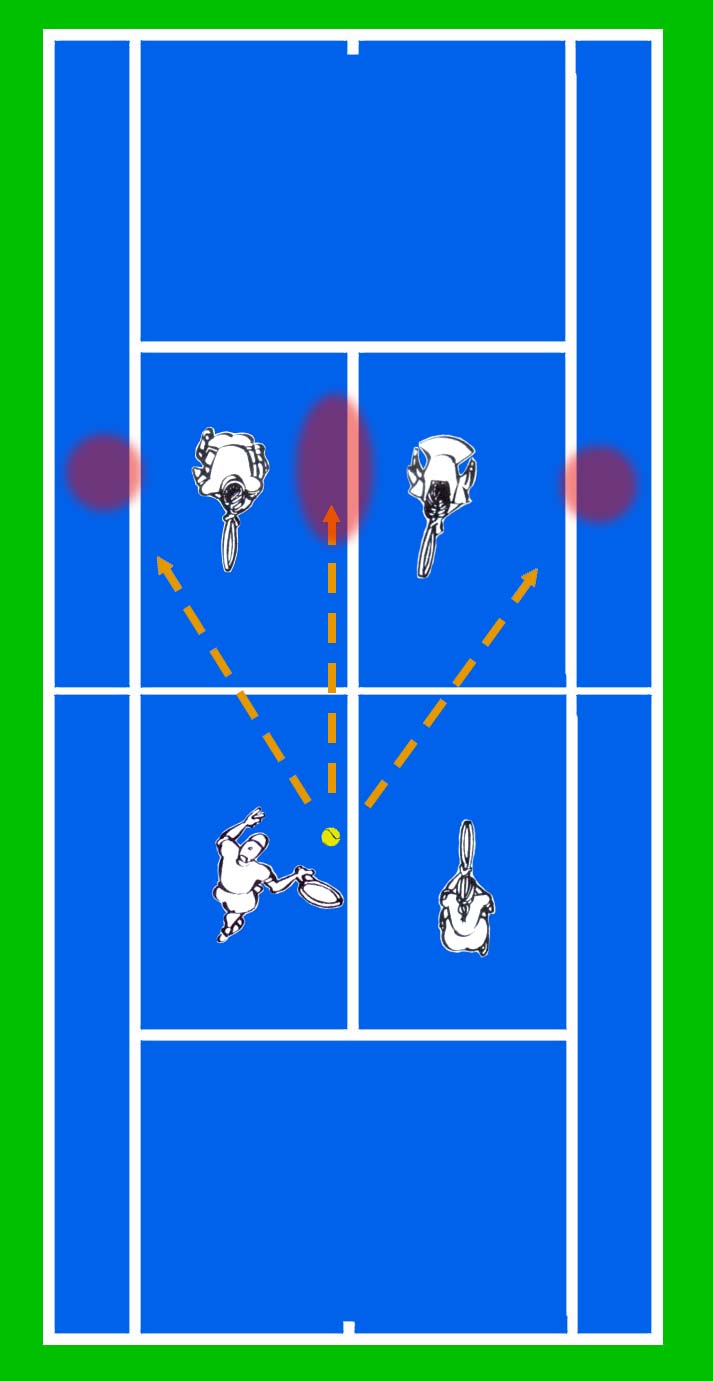 Those are the general rules for choosing a target, regardless of where you are on court. Now lets consider some of the shots we may have to handle, and discuss what to do in each case. There are four general categories:
Those are the general rules for choosing a target, regardless of where you are on court. Now lets consider some of the shots we may have to handle, and discuss what to do in each case. There are four general categories:
- The Inside Volley
- The Outside Volley
- The Inside Ground Stroke
- The Outside Ground Stroke
Volley from the Middle
When our opponent hits us a ball down the middle, she is forcing us to play an inside volley. It's no surprise that the vast majority of volleys that we hit will be in the middle of the court. This is the easiest place for either us or our opponent to place the ball. Where should we try to place the ball when we receive a shot down the middle?
If our opponents are also in the forward volley position, there are really three small targets we should try to hit, which are highlighted in the diagram to the right. Note that they are all three at about the same depth as the opponent's feet, so as to make them hit a low ball. The easiest, and most predictable one is down the middle. It's easiest, because it allows the largest margin of error, and is most predictable for the same reason. It is also the area that the opponents are most likely to protect. You should choose this shot if the opponent has hit a shot that is either very low, or has a lot of pace, or if you have had to take a few steps back to hit an overhead. The opponents will likely get the ball back in play, but if you are able to place the ball at a depth near their shoes, you will likely get a weak return.
If the ball you receive comes at a slower pace, or you can hit it while it is still above the level of the net, you can choose one of the other two offensive targets in or near the alley. Keep in mind that it's more important to make your opponent hit a low ball than it is to put pace on the ball, especially when you are attempting angle shots. Finally, as we said earlier in this chapter, the hitting player should try to keep the ball in front of himself and his partner, so his best choice would be to the right alley target. Why? Because if the opponent gets to the ball, you and your partner are already in the ideal defensive position. If you hit the ball toward the left alley target, both you and your partner have to quickly move left to defend against the opponent's most likely shots.
If one or both of your opponents are at the baseline, your targets shift only slightly. The center shot could then be placed near the baseline with a little added pace, and the outside target could move back to about even with the service line on the side (sides) where the player is back. Note that any time one opponent is back, your ideal targets get bigger. For instance, if the deuce court opponent were at the baseline, your right alley target would not move backward, but would merely extend further back.
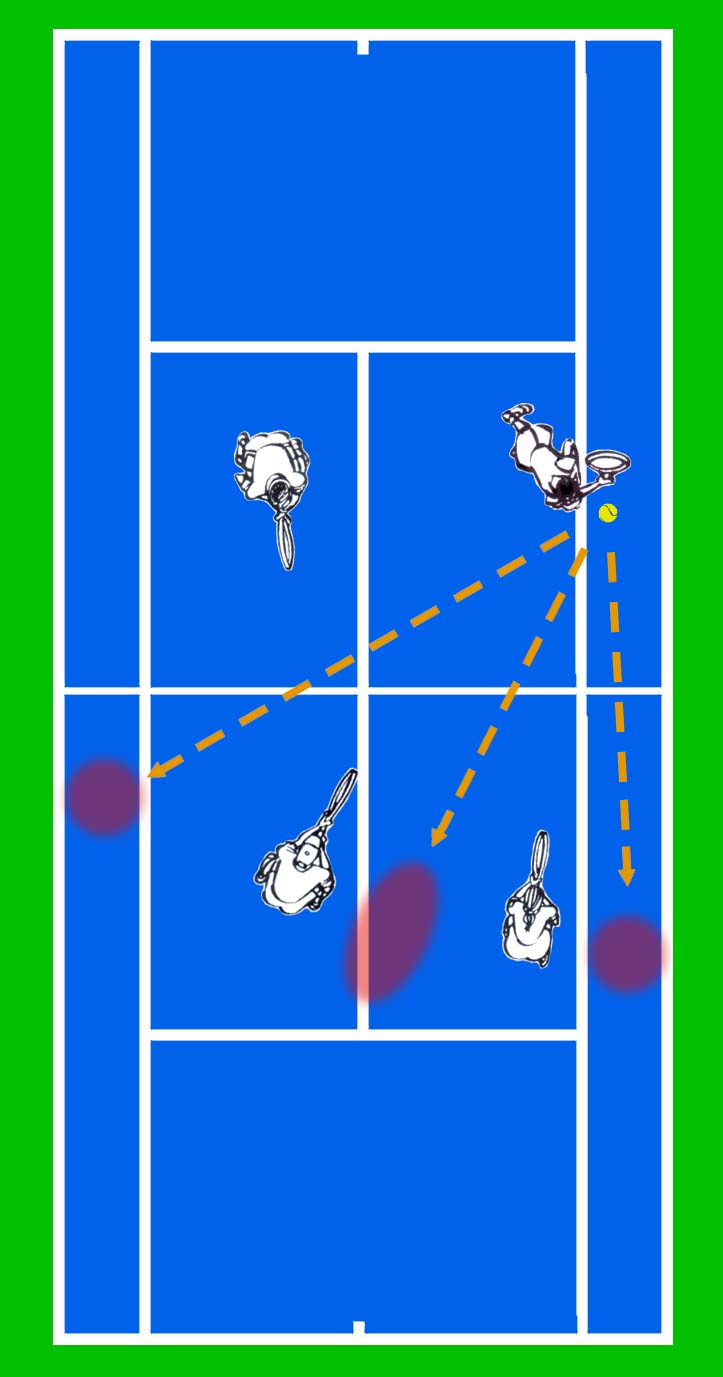
Volley from the Outside
In the diagram to the left, the player in the upper ad court is about to make an outside volley. Note that her targets are similar to those she would have if the ball had been down the middle, with the exception of the crosscourt outside shot. Again, the shot between the two defenders would be the preferred shot if she was hitting from below net level, or was handling a very hard drive. But her down-the line shot is a very good second choice for two reasons. First, and foremost, it keeps the ball in front of her and her partner, which is a big advantage, because neither of them have to move from their current positions to defend against the possible return. Second, it completely takes one of the opposing partners out of the equasion. Also, if the ball is high, you have a chance to drive the ball at a reasonable pace, so the nearer player has very little time to react to your shot.
The sharp cross-court shot is the third possibility, but you should only choose this shot if you are well positioned to make it, and the ball is above shoulder height. Otherwise, you will have to take pace off the ball to get it to drop into the court, and the defender on the left side will have a chance to hit the ball at a high enough point to give your partner an almost impossible shot.
What if your opponent in the left court is at the baseline? Now the cross-court angle is your best bet, because there's no opponent to cover the shot. Even if you are taking the ball very low, if you can keep it in the court and get a reasonable angle on it, neither of the opponents will be able to reach it.
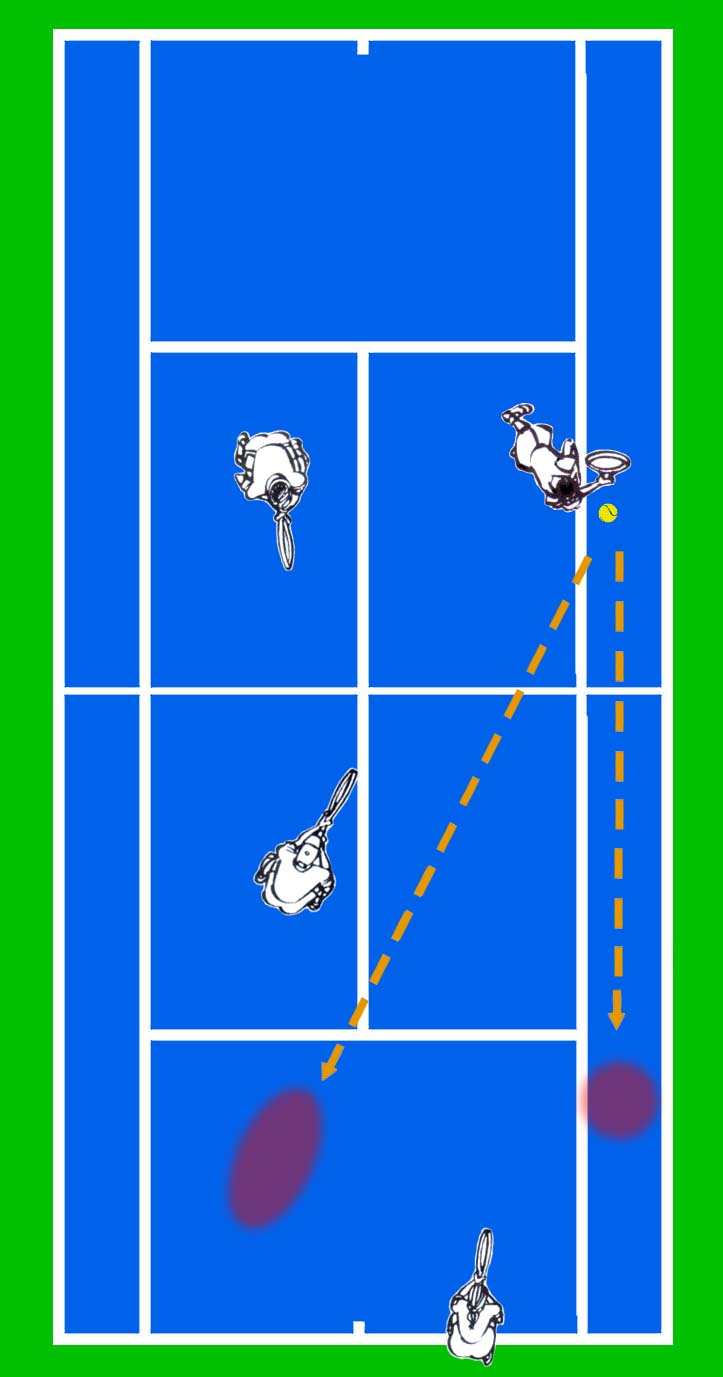 Even if the baseline player does reach the ball, he will be off court, leaving you and your partner with a lot of undefended space into which to hit the next ball.
Even if the baseline player does reach the ball, he will be off court, leaving you and your partner with a lot of undefended space into which to hit the next ball.
If your deuce court opponent is at the baseline, you have an obvious open spot between the two players. You could also try to drop the ball down the line, or hit a drive down the line, depending on how deep the deuce court player is, and if the ball you are hitting is shoulder high, you have a good chance to hit a winner. These are the kind of opportunities you should take advantage of when they arise. The only rule here is, don't hit at either player. As we said before, your target is the ground on your opponent's side of the court, so aim for the biggest undefended area.
Inside Ground Stroke
You are at the baseline and your opponent has just hit a volley down the middle. You are about to hit a ground stroke from near the center of the baseline. What are your choices? This is the classic example of the axiom Deep to deep, short to short.You are deep in your court. If one of your opponents is also deep, you should hit the ball toward that person. But a better way to describe what you should do is keep the ball away from the short player. Since we are hitting the ball, we must try to execute an offensive play, which means hitting the ball where the opponent isn't, or at least where it's not easy for him to return. Yes, you want to force the deep player to play the ball, but you also want to make it difficult for him. The only way to accomplish this by hitting at him is to aim a screamer at the toes of his sneakers. Surely you know how hard it is to hit such a small target with pace.
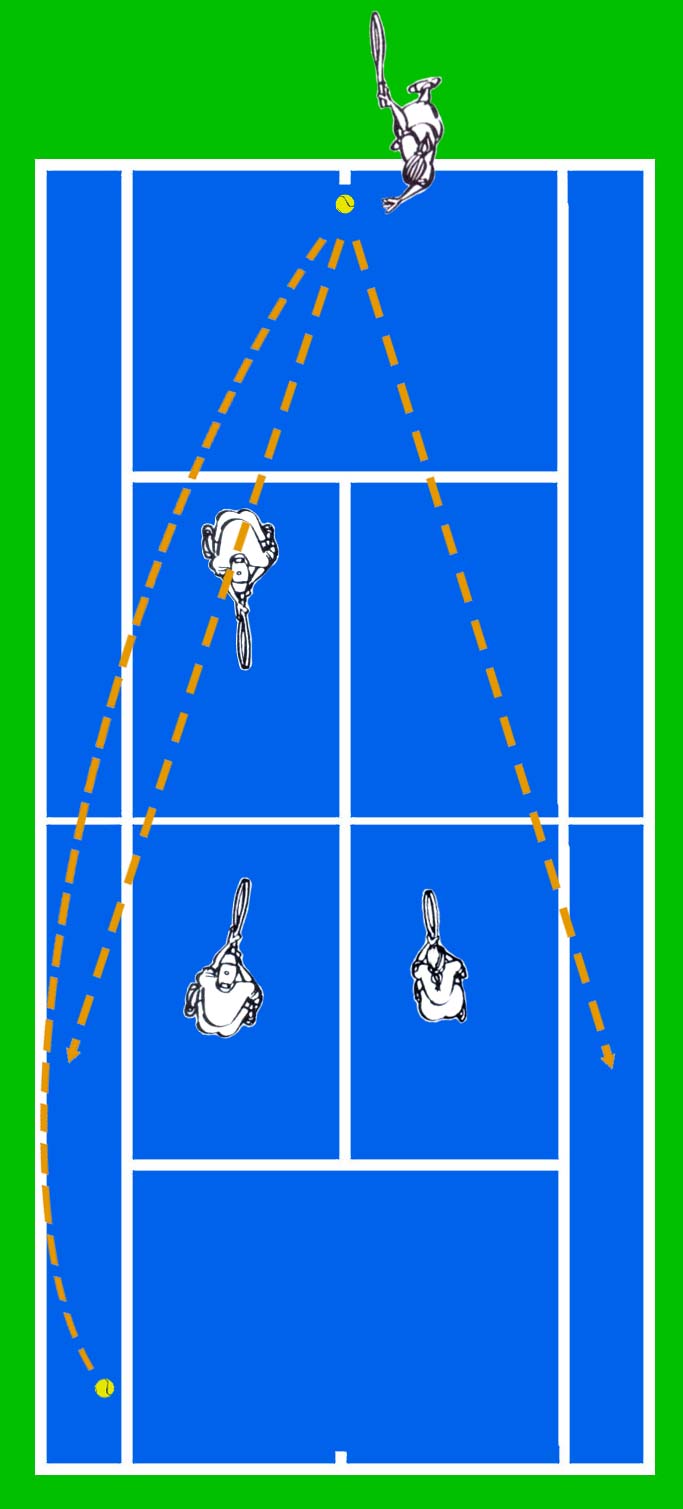
Let's also examine your choices when both your opponents are near the net. Here, you are under extreme pressure, for you must hit a shot that is challenging to your opponents, who are basically in control of the point. The further back you are, the harder this will be to accomplish. The choices are a hard drive down the middle (at the lowest part of the net), a hard drive that lands in either alley, or a high lob that lands near the baseline. Keep in mind that you still want to get your drive to hit the ground at about the depth of your opponents' feet, so you must hit a ball that clears the net by a small margin, and drops rapidly once it's over the net. This is considerably more difficult than hitting a lob that will land in the back 8 feet of the court, which is your other choice. From the center of the back court, it wouldn't seem to matter where you place your lob, as long as it's deep enough to make your opponent take it after the bounce. Not so if your partner is at net. In this case you must lob to the corner that is in front of your partner, and your partner must move back a small amount to allow himself to handle an overhead, should your lob not be deep enough. Should he retreat to the baseline? Probably not, unless you are struggling with your shot, but he must still be prepared to defend his portion of the court. Putting the ball deep into the corner in front of your partner gives him the maximum time to adjust his position for the possible overhead, and yet, if the ball goes over the opponent's head, he has time to regain his ideal position nearer the net. This is a perfect example of why the partner not hitting the ball still has a responsibility to move so he can effectively defend his court.
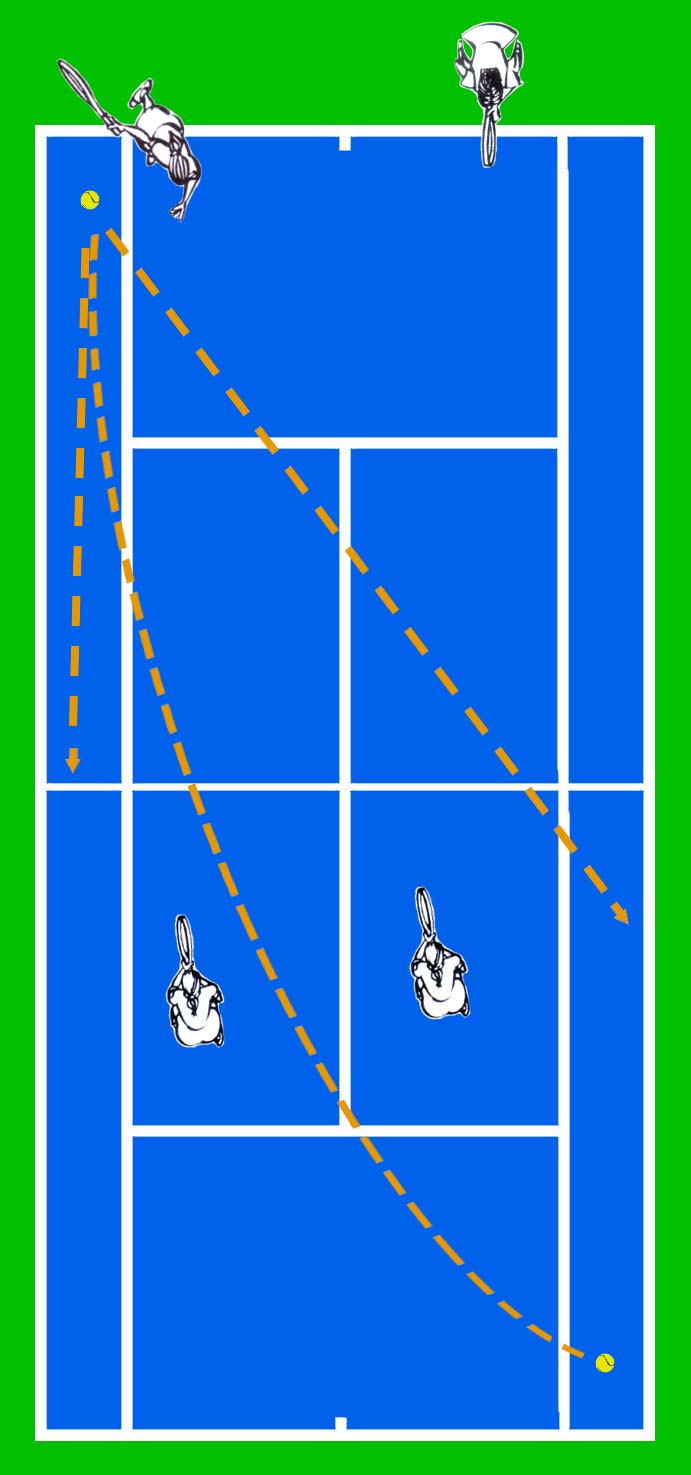
Outside Ground Stroke
When you are at the baseline and are forced to hit a ball from either corner of your court, you face three possible situations:
1. Both your opponents are at the baseline
2. One opponent is at the baseline and the other at net
3. Both opponents are at the net.
You can only hope that your opponents will be dumb enough to both stay at the baseline while you chase down a ball that they placed near the back corner of the court. If they were, you can hit a shot just about anywhere and set yourself and your partner up to move in to the ideal volley position. The best shot, in this situation would be a crosscourt shot that lands in your opponent's alley. Why? because it is the one shot that will make the hitter move. An alternative would be a down-the-line drive, but only if the opponent has left enough space that he will have to move to get to your shot.
The most likely situation you will face is one opponent at net and the other near the baseline, and the crosscourt opponent will most likely be the one near the baseline. This is the typical situation that exists when the server did not serve-and-volley. Your situation is more difficlut than when both opponents were at the baseline, and you have fewer options. Your best play is still a crosscourt drive that lands in the opponents alley. The down-the-line drive is now a risky option because if you fail to pass the player at net, she can easily hit a cross-court winner between you and your partner. (Remember, Your partner has a duty to move forward when the opponent in front of him is back. If you don't put the ball in front of him, you lose the advantage given you by the deep opponent.) While we're at it, let's consider what your partner should be doing. If you don't have sufficient time to set up and hit your preferred shot, your partner needs to pull back and toward the center of the court to narrow the possibilities of the net player, should you not be able to keep your shot far enough from him to avoid his poaching and placing the ball between the two of you.
Finally, what if both your opponents are in the ideal controlling position? If you've had plenty of time to set up on the ball, you could try a sharp cross court shot which would make one of your opponents move to the outside, possibly creating an opening down the middle for the next shot. You could also try a hard drive down the line into your opponent's alley, which could also create an opening in the middle. It is not likely you could do much damage to your opponents by driving the ball between them unless you see that they are too far apart. Overall, your best, and probably easiest shot is a crosscourt lob. This will force one of your opponents off the net, and give both you and your partner time to move in closer to the ideal controlling position. Just remember that once the ball leaves your racquet, you are back on defense again, and both you and your partner must assess how effective your shot is, and move accordingly to defend against the opponent's possible choices.
The Role of the Non-Hitting Player
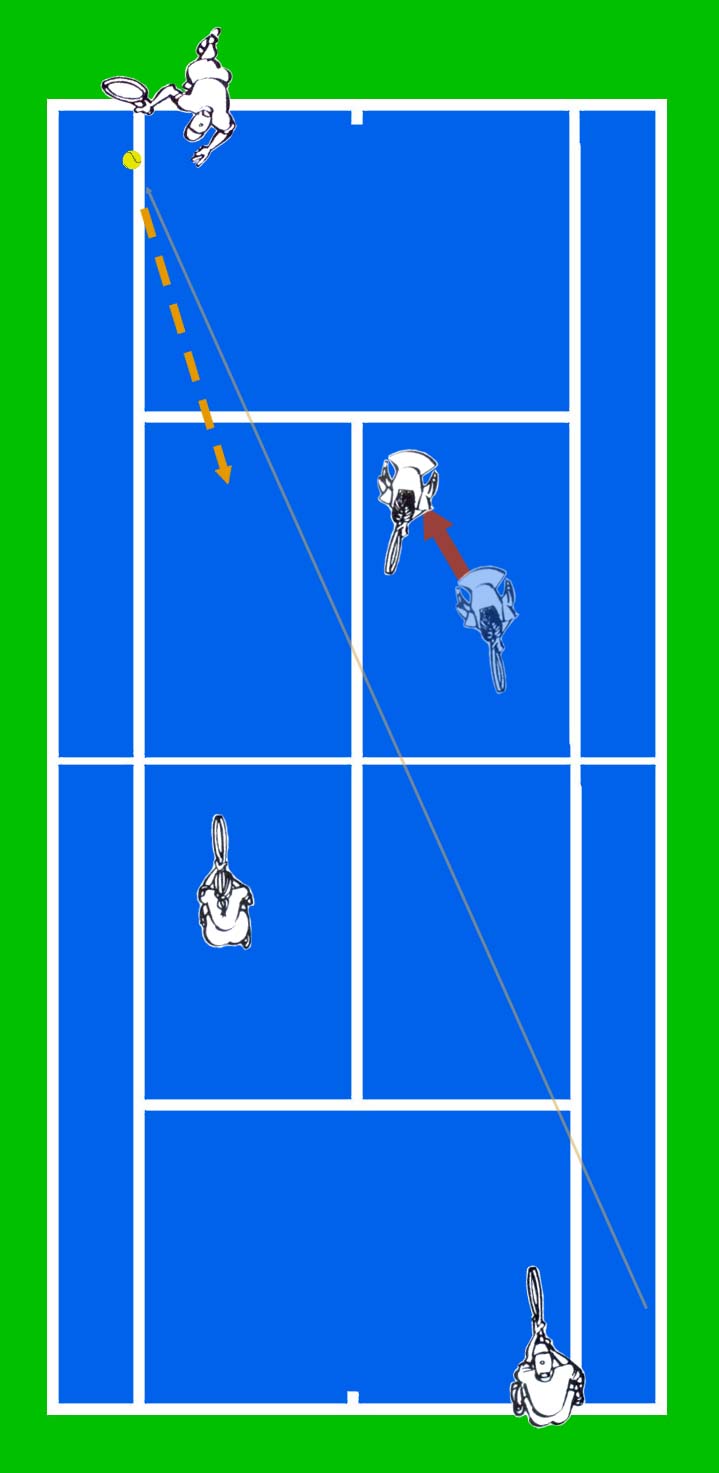 Have you ever watched a foursome playing tennis and seen the ball being stroked back and forth by two players who are cross-court from each other, while the other two players, at the net, bob their heads back and forth watching the ball, and not moving a step. This is a typical situation that happens to 3.0 players who have gained a lot of consistency in their strokes, but who have not yet learned doubles strategy. By it's very name, doubles connotates two players working as a team. When the ball goes to your partner, she becomes the offensive player, but you remain on defense. Consider. for instance, the typical situation that usually happens right after the serve and the return of serve. Especially in senior's tennis, there are rallies where the server and receiver are hitting ground strokes back and forth to each other. While this is happening, should the other two players be picking their noses? Look at the diagram to the left. Notice that the partner of the hitter has moved slightly back and toward the center of the court. There is a good reason why this should happen on every deep-to-deep crosscourt shot.
Have you ever watched a foursome playing tennis and seen the ball being stroked back and forth by two players who are cross-court from each other, while the other two players, at the net, bob their heads back and forth watching the ball, and not moving a step. This is a typical situation that happens to 3.0 players who have gained a lot of consistency in their strokes, but who have not yet learned doubles strategy. By it's very name, doubles connotates two players working as a team. When the ball goes to your partner, she becomes the offensive player, but you remain on defense. Consider. for instance, the typical situation that usually happens right after the serve and the return of serve. Especially in senior's tennis, there are rallies where the server and receiver are hitting ground strokes back and forth to each other. While this is happening, should the other two players be picking their noses? Look at the diagram to the left. Notice that the partner of the hitter has moved slightly back and toward the center of the court. There is a good reason why this should happen on every deep-to-deep crosscourt shot.
Any time your deep partner is hitting the ball, and the opponent in front of him is near the net, you are responsible for defending as much court as possible against the opponent who has a possibility of poaching. If you don't drop back a bit, move toward the center of the court, and face the net opponent. she can easily place any ball within her reach between you and your partner for a winner. By dropping back, moving toward the center, and focusing on the near opponent, you decrease that possibility. In addition, with you defending the center of the court, your partner now can "consider" driving the ball down the line. Once your partner's ball passes the opposing net player, and not sooner, you can move forward and mirror the opponent who will be striking the next shot. If you move forward before you know that the opposing net person cannot strike the ball, you leave an opening for a winning shot between you and your partner.
Also notice that the opponent in the bottom forecourt has moved slightly to her left and forward so she has a better chance of defending against the down-the-line possibility of the hitter. In any deep-to-deep crosscourt ralley, the players at net should be constantly moving... forward and toward the alley when the ball has passed their opponent at net, and back and toward the center when the ball has passed them toward the back of their court. If you get lazy and don't do this, you not only open up possibilities for your opponents to hit winners, but you also put a big restriction on the kind of shot your partner can safely attempt.
This is only one example of how important your job is when your partner is hitting the ball. Your partner's position on court is dictated by the ball he has to hit. Your responsibility is to defend the portion of the court that he can't defend. Don't go to sleep on the job
Next: 5 - Serve and Return